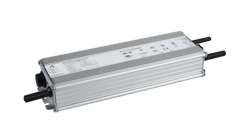SHASHANK NALLA discusses the design philosophy and architecture of LED drivers from Osram Digital Systems with MAURY WRIGHT in an interview — specifically, the smart capabilities of the Sapphire Award-winning Optotronic Programmable LED Emergency Driver.
LEDs Magazine announced the winners in the 2018 Sapphire Awards program on February 14, 2018 in Long Beach, CA, at a Gala that took place aboard the RMS Queen Mary. The Gala, held coincident with the Strategies in Light tradeshow, included compelling entertainment, fantastic networking, and a chance to celebrate the stars of the solid-state lighting (SSL) sector. Osram Digital Systems took Sapphire honors on the night in the Constant Current LED Driver category with the Osram Optotronic Programmable LED Emergency Driver. The judges applauded the integration of Emergency Mode (EM) support and the programmability and smart-lighting features designed into the product. We recently had a chance to talk with Shashank Nalla, product marketing manager of digital systems for the Osram Americas Region, about the architecture of the driver and the philosophy behind the feature set.
Shashank Nalla
LEDs Magazine:Hi, Shashank, and congratulations on winning an LEDs Magazine Sapphire Award for your Osram Optotronic Programmable LED Emergency Driver. We’ve regularly written that drivers are as important as the LEDs in delivering high-quality solid-state lighting (SSL) products for the general illumination sector. That statement rings true both in terms of product reliability and lifetime and in terms of light quality including minimal flicker, smooth dimming, and other characteristics. Your Osram Digital Systems team went further, adding features such as programmability and auxiliary power outputs — and then developed this model with both normal and emergency modes. Clearly, our Sapphire judging panel valued theinnovation.
Tell us first about the inspiration behind the emergency lighting support. How did you make the decision to integrate it in the driver and what was the development process like?
Shashank Nalla: Fixture manufacturers who provide emergency lighting solutions have always expressed their pain points in dealing with the development of these solutions. Some of those pain points include the selection of components, ensuring compatibility with LED drivers and LED modules, manufacturing, and post-salesservicing.
Osram has decided that this could be an opportunity for us to help OEMs deal with these problems. This has led us to start thinking and developing the Emergency LED driver portfolio, which will help alleviate these issues and support them with emerging smart building trends.
We started off with our core functionality of LED drivers: They are programmable and integrate an emergency functionality that will help OEMs increase flexibility in addressing application and component selection, ensure compatibility, and provide the benefits of seamless integration into connected lighting.
The development process was exciting and presented us with an opportunity to understand more about the market and the details of this application segment. The teams were focusing on driver design and battery pack designs, which represent the high quality that Osram stands for.
Sapphire Award-winning Optotronic Programmable LED Emergency Driver from Osram Digital Systems.
LEDs:Did the development process in the case of this driver product follow a normal pattern in terms of concept, design, and implementation? How much input did you get from customers and partners? How did you decide which features to add and maybe which features just couldn’t deliver return oninvestment?
Nalla:Since the driver design is completely different from a traditional LED driver in terms of accommodating battery charging circuit, design of battery packs, harnesses, it required us to develop an entirely new approach. We had customers involved at every stage of the development to ensure we were meeting their needs andexpectations.
Osram is well known for technical excellence and feature-rich products. We have done a detailed analysis of features versus cost and we are constantly inquiring with the market to ensurerelevance.
LEDs:Connectivity and smart lighting are significant trends today in the SSL sector. The judges surely valued that your team included an optional auxiliary power output that could power a module with sensing and wireless/wired connectivity capabilities. What was your thinking on how to support connected luminaires, and would you expect connectivity to be soon integrated into drivers or does the fragmented market mean modular approaches will dominate?
Nalla:We wanted to ensure that our Hybrid Emergency LED drivers are not short of enabling connectivity in any operating mode. This is the ‘mantra’ for our entire LED driver portfolio. I expect the modular approach will still be in the best interest of the industry given the many unknowns in the market.
LEDs: Regarding the emergency mode of your products, the documentation suggests that the driver automatically performs recurring tests of that capability as required by some regulations in different regions. Can you provide more details on exactly how that testing works, and how the facilities personnel would document the emergency mode testing?
Nalla:Our drivers now have a feature called Self-Test, which will allow for automatic testing of the battery packs as required by the code, ensuring the health of the EM Solution. These tests are run monthly and annually, and the feedback of this testing is given out through the LED Test Switch, connected to the driver. This allows the facility manager to take care of fixtures which are showing issues through this outward visible switch instead of sending personnel to manually test every emergency fixture.
LEDs:If you had a luminaire with a connectivity module connected to the driver, could you remotely monitor the status of emergency mode testing?
Nalla: This feature is not available in our currentofferings.
LEDs: What are the advantages of having the emergency mode integrated into the same driver that powers normal lighting modes? Is it the fast switching time primarily? Is there a cost of goodsadvantage?
Nalla:The major advantages are:
•Simplified fixture design
•Simplified manufacturing for OEMs
•Reduced cost through fewer components — no need for a dedicated LED driver
•Since it’s programmable in EM mode:
-OEMs can build the fixture so the output during EM mode can be tuned for various application heights and meeting the code, thereby not wasting extra lumens or underestimating the lumen requirements
-OEMs can reduce their SKU count
•Through a dedicated and fool-proof harness, the solution supports simpler manufacturing steps and post-installation service calls
LEDs: In a facility, a specifier would install the emergency-capable drivers in a small percentage of the overall luminaires, right? In terms of the normal illumination mode, is the driver circuit identical in drivers with and without the emergency mode? Would characteristics such as flicker and dimming performance beidentical?
Nalla:We made sure that the performance of emergency drivers in Normal mode would be identical with our normal LED drivers for dimming and flickerperformance.
LEDs:We know Osram has been successful in the driver business both supplying internal customers and other lighting manufacturers. Indeed, in our visit to some of the largest lighting manufacturers around the globe, we have seen test benches and manufacturing lines with Osram drivers evident. Is it the performance of the products that most often wins you business? What do you do to minimize flicker? How do you ensure smooth dimming? What are the critical features to yourcustomers?
Nalla:The reason our drivers are well accepted in the industry is that we pay a lot of attention to the needs of our customers. The features combined with best-in-class reliability makes us win. Flicker minimizing is a design feature that we ensure is done across the portfolio, and this is true for dimming also. We have years of experience in mastering these circuits andproduction.
Critical features in our offerings that customers utilize and appreciate are:
•Programmable currents
•Programmable AUX power channel
•Programmable dim to off — no need for mechanical relay or power packs
•Programmable dimming
•Programmable thermalprotection
•End-of-life feature
•Constant lumen feature
•Dimming consistency andperformance
•Wide operating voltage current and power ranges
LEDs:We noted in your documentation that you offer a number of battery options for the emergency mode support. Can you tell us about the options and why there are choices? Is the flexibility in place to support different regulatory environments? Does luminaire form factor come into play?
Nalla:The battery configurations are mainly for accommodating different fixture types. This is another example of our customers’ involvement and feedback ensuring our solutions meet their demand.
LEDs:In terms of connecting the battery, we understand that your team engineered a novel harness that simplifies the process. Can you tell us more about the philosophy behind that interconnect and exactly how it works?
Nalla:The philosophy for our interconnect is to make both production and post-sale servicing simple and efficient for production and field personnel who often have a tough time dealing with multiple wires in a traditional solution.
With this in mind, we made sure to have a single harness connection that is ensured to work each and every time.
LEDs:Last, we’d like to address the programming capabilities of the drivers. One reason that programmability is important is so that luminaire manufacturers can stock fewer SKUs, right? But clearly you are using the programming capability to offer luminaire manufacturers more control of their end-product feature set. Please describe the other features that can be programmed such as LED thermal protection and constant lumen mode.
Nalla: With programmability, we give the luminaire manufacturers full control of product features (mentioned above) that they want to bring into market as part of theirofferings.
LED thermal protection helps to increase the reliability of their fixtures based on their application, and constant lumen mode ensures that the fixture always emits the same amount of light throughout its lifetime by increasing the current in the future to compensate the LED lumendepreciation.
LEDs: Osram as a whole and Osram Digital Systems has a great reputation and a compelling SSL portfolio, so winning an award is probably not a surprise. Still, we would ask what it meant to your team to win Sapphire. And why did the team decide to enter the Optotronic Programmable LED Emergency Driver in our program?
Nalla:Winning the Sapphire Award is very exciting for the entire team; we feel that our hard work and dedication have been recognized, as well as our commitment to bringing innovative solutions to market.
Links
Sapphire Awards now open for submissionsThe LEDs Magazine Sapphire Awards is now in its fifth year and will feature 15 product/technology categories, as well as the Illumineer of the Year recognition. The main thing that really stands out in the Sapphire Awards program is that it truly recognizes the importance of a breadth of technologies across the LED and lighting industry. The call for entries is now open. Whether you’re a “young upstart” or an established leader in lighting, we’re looking for your contributions to the new era of SSL technology. Visit the Sapphire Awards to learn more about the program and the Awards Gala, find category descriptions, and submit your SSL products or your nominations for the Illumineer of the Year.








